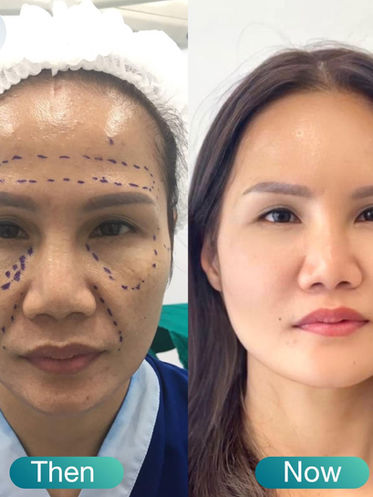
Fat Grafting
Fat grafting is the process of harvesting fat from your own body and injecting healthy fat cells into areas you want to enhance. Common areas include the forehead, under the eyes, temples, breasts, hips, or buttocks. It’s a popular choice for those who are concerned about allergic reactions from fillers. The advantage of fat grafting is that your body won’t reject it, since the cells come from your own body, and it will naturally break down over time sometimes faster than fillers in certain patients.
Fat Preparation for Injection
Fat grafting to rejuvenate the face or enhance other areas, such as the breasts, consists of 3 main steps:
1. Fat Harvesting
This first step is crucial. For facial fat grafting, we often use the manual technique (hand aspiration) combined with the Superwet Technique for local anesthesia to minimize trauma to fat cells. For areas requiring more fat, such as the breasts, machine-assisted liposuction may be used.
Fat can be taken from any area, but the most effective donor sites with abundant fat are:
-
Outer thighs
-
Lower abdomen
-
Inner thighs
Unlike full liposuction for body contouring, harvesting fat for grafting is simpler. The process involves marking the donor site, injecting local anesthesia, and extracting the fat. This takes about 15–30 minutes, depending on location and volume. The outer thighs are the least painful and yield fat easily, making them the most popular choice.
2. Fat Processing & Separation
Harvested fat contains local anesthesia and other components, so it must be processed to separate it into layers:
-
Oil
-
Adipose tissue (fat cells)
-
Other components (blood, AD-SVF, and surrounding substances)
The usable fat is separated into:
-
Microfat – larger fat particles for deep areas (forehead, temples, nasolabial folds)
-
Nanofat – finer fat particles for superficial areas (under-eye hollows, fine nasolabial lines)
-
AD-SVF – rich in stem cells and growth factors for skin rejuvenation, wrinkle reduction, and improved skin quality
3. Fat Injection
This step requires skill and artistry. We use the Micro Droplet Multi-layer Technique, spreading tiny fat parcels evenly across multiple layers to maximize blood supply and graft survival. This method helps avoid lumps, ridges, or irregularities.
Microfat is used for deep structural support (forehead, temples, under cheekbones), while Nanofat is injected more superficially (under eyes, fine lines), leading to smoother, more refined results.
Common Fat Grafting Areas
-
Forehead – Creates a smooth, curved contour that balances facial shape.
-
Temples – Corrects hollow temples, lifts outer brows and eyes, and provides a youthful appearance.
-
Under Eyes – Reduces hollowness and dark circles using Nanofat in small amounts to prevent lumps when smiling.
-
Nasolabial Folds – Deep layers are filled to reduce crease depth, while Nanofat is used for surface refinement.
-
Under Cheekbones – Softens sharp angles for a more gentle facial outline.
-
Marionette Lines & Chin – Fat can improve deep lines, but fillers are generally preferred for better shape retention in these areas.
-
Hollow Lower Cheeks – Not recommended for fat grafting due to the risk of sagging from fat weight. Laser lifting or facelift with fillers is preferred.
Other Body Fat Grafting Areas
-
Breasts – Best for enhancing cleavage or improving shape without a large size increase; suitable for mild sagging. For significant enlargement, implants are more appropriate.
-
Female Genital Area – Improves fullness of the mons pubis and labia majora, enhancing aesthetics in swimwear and helping with dryness or irritation.
-
Hands – Makes hands look younger by reducing the visibility of veins, tendons, and bones.
Note: Buttock and hip fat grafting are not recommended due to the large volume required and higher complication risk.
Skin Rejuvenation Benefits
Beyond adding volume, fat grafting improves skin quality thanks to AD-SVF, which contains:
-
Stem cells (MSCs)
-
HSCs, Treg & Monocytes
-
Progenitor cells
-
Perivascular cells
These help by:
-
Cell regeneration – Repairs and strengthens skin cells, reducing dryness, sensitivity, acne, melasma, and pigmentation.
-
Anti-aging – Makes cells more youthful, reducing fine wrinkles and improving long-term skin health.
-
Vascular repair – Improves skin blood supply and reduces inflammation.
-
Immune support – Enhances overall cell function.
Fat vs. Filler
-
Filler – Easy to control results, minimal downtime, less pain, but certain areas carry higher risk and can appear less natural.
-
Fat – More natural feel, especially in the forehead; permanent integration with your skin more cost-effective for large volumes (3–4+ filler syringes).
Longevity of Results
After injection, about 30–40% of fat cells die off. The remaining cells behave like your own fat and last for years, gradually diminishing with age.
Recovery & Downtime
-
Swelling – Heaviest at 5–10 days, improves by 2 weeks, final results at 4 weeks. Initial swelling is 30–40% greater than the final outcome.
-
Exercise – Avoid for 1 month. also avoid facial massage and heat treatments.
-
Pain – Minimal. Local anesthesia is used for both harvesting and injection. Sedation options are available for anxious patients.








